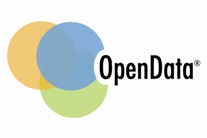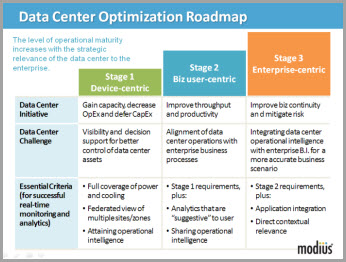 Modius OpenData has recently reached an intriguing milestone. Over half of our customers are currently running the OpenData® Enterprise Edition server software on virtual machines (VM). Most new installations are starting out virtualized, and a number of existing customers have successfully migrated from a hard server to a virtual one.
Modius OpenData has recently reached an intriguing milestone. Over half of our customers are currently running the OpenData® Enterprise Edition server software on virtual machines (VM). Most new installations are starting out virtualized, and a number of existing customers have successfully migrated from a hard server to a virtual one.
In many cases, some or all of the Collector modules are also virtualized “in the cloud,” at least when gathering data from networked equipment and network-connected power and building management systems. It’s of course challenging to implement a serial connection or tie into a relay from a virtual machine. It will be some time before all possible sensor inputs are network-enabled, so 100% virtual data collection is a ways off. Nonetheless, we consider greater than 50% head-end virtualization to be an important achievement.
This does not mean that all those virtual installations are running in the capital-C Cloud, on the capital-I Intranet. Modius has hosted trial proof-of-concept systems for prospective customers on public virtual machines, and a small number of customers have chosen to host their servers “in the wild.” The vast majority of our installations, both hardware and virtual, are running inside the corporate firewall.
 Many enterprise IT departments are moving to a virtualized environment internally. In many cases, it has been made very difficult for a department to purchase new actual hardware. The internal “cloud” infrastructure allows for more efficient usage of resources such as memory, CPU cycles, and storage. Ultimately, this translates to more efficient use of electrical power and better capacity management. These same goals are a big part of OpenData’s fundamental purpose, so it only makes sense that the software would play well with a virtualized IT infrastructure.
Many enterprise IT departments are moving to a virtualized environment internally. In many cases, it has been made very difficult for a department to purchase new actual hardware. The internal “cloud” infrastructure allows for more efficient usage of resources such as memory, CPU cycles, and storage. Ultimately, this translates to more efficient use of electrical power and better capacity management. These same goals are a big part of OpenData’s fundamental purpose, so it only makes sense that the software would play well with a virtualized IT infrastructure.
There are two additional benefits of virtualization. One is availability. Whether hardware or virtual, OpenData Collectors can be configured to fail-over to a secondary server. The database can be installed separately as part of the enterprise SAN. If desired, the servers can be clustered through the usual high-availability (HA) configurations. All of these capabilities are only enhanced in a highly distributed virtual environment, where the VM infrastructure may be able to dynamically re-deploy software or activate cluster nodes in a number of possible physical locations, depending on the nature of the outage.
Even without an HA configuration, routine backups can be made of the entire virtual machine, not simply the data and configurations. In the event of an outage or corruption, the backed-up VM can be restored to production operation almost instantly.
The second advantage is scalability. Virtual machines can be incrementally upgraded in CPU, memory, and storage capabilities. With a hardware installation, incremental expansion is a time-consuming, risky, and therefore costly, process. It is usually more cost-effective to simply purchase hardware that is already scaled to support the largest planned installation. In the meantime, you have inefficient unused capacity taking up space and power, possibly for years. On a virtual machine, the environment can be “right sized” for the system in its initial scope.
Overall, the advantages of virtualization apply to OpenData as with any other enterprise software. Lower up-front costs, lower long-term TCO, increased reliability, and reduced environmental impact. All terms that we at Modius, and our customers, love to hear.



